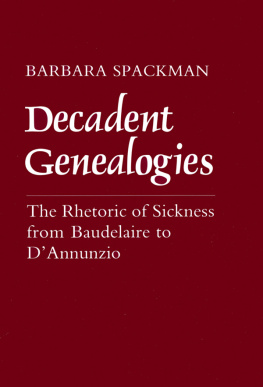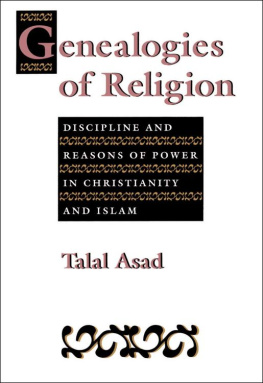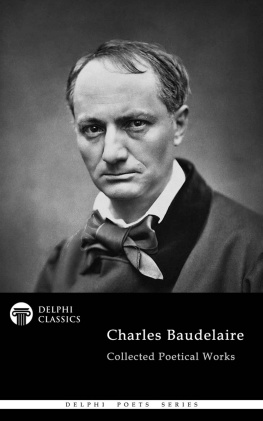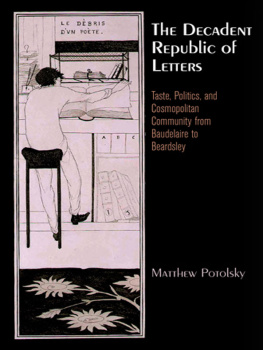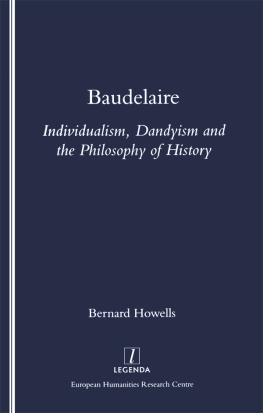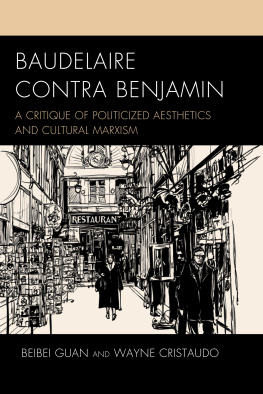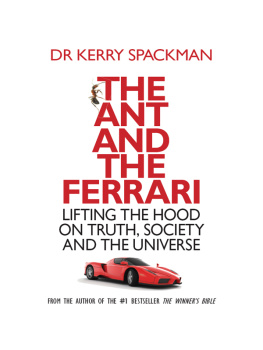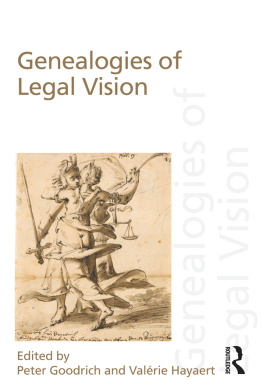Spackman - Decadent genealogies: the rhetoric of sickness from Baudelaire to DAnnunzio
Here you can read online Spackman - Decadent genealogies: the rhetoric of sickness from Baudelaire to DAnnunzio full text of the book (entire story) in english for free. Download pdf and epub, get meaning, cover and reviews about this ebook. City: Ithaca;NY, year: 1989;2018, publisher: Cornell University Press, genre: Detective and thriller. Description of the work, (preface) as well as reviews are available. Best literature library LitArk.com created for fans of good reading and offers a wide selection of genres:
Romance novel
Science fiction
Adventure
Detective
Science
History
Home and family
Prose
Art
Politics
Computer
Non-fiction
Religion
Business
Children
Humor
Choose a favorite category and find really read worthwhile books. Enjoy immersion in the world of imagination, feel the emotions of the characters or learn something new for yourself, make an fascinating discovery.
- Book:Decadent genealogies: the rhetoric of sickness from Baudelaire to DAnnunzio
- Author:
- Publisher:Cornell University Press
- Genre:
- Year:1989;2018
- City:Ithaca;NY
- Rating:3 / 5
- Favourites:Add to favourites
- Your mark:
- 60
- 1
- 2
- 3
- 4
- 5
Decadent genealogies: the rhetoric of sickness from Baudelaire to DAnnunzio: summary, description and annotation
We offer to read an annotation, description, summary or preface (depends on what the author of the book "Decadent genealogies: the rhetoric of sickness from Baudelaire to DAnnunzio" wrote himself). If you haven't found the necessary information about the book — write in the comments, we will try to find it.
Spackman: author's other books
Who wrote Decadent genealogies: the rhetoric of sickness from Baudelaire to DAnnunzio? Find out the surname, the name of the author of the book and a list of all author's works by series.
Decadent genealogies: the rhetoric of sickness from Baudelaire to DAnnunzio — read online for free the complete book (whole text) full work
Below is the text of the book, divided by pages. System saving the place of the last page read, allows you to conveniently read the book "Decadent genealogies: the rhetoric of sickness from Baudelaire to DAnnunzio" online for free, without having to search again every time where you left off. Put a bookmark, and you can go to the page where you finished reading at any time.
Font size:
Interval:
Bookmark:

The nineteenth-century theorization of mental illness passed first through the sick body of the degenerate: sick bodies produced sick thought. As a scientific model, pre-Freudian theories of degeneration enjoyed a brief, though influential, reign. As a set of rhetorical strategies with which to describe not only sick bodies and their thoughts but also social classes, political positions, genders, and even literary texts, those theories continued to hold sway well into the twentieth century. Thus, though the texts that bear the names of Cesare Lombroso, Friedrich Nietzsche, Benedetto Croce, Max Nordau, Antonio Gramsci, G. A. Borgese, Georg Lukcs, Charles Baudelaire, J. K. Huysmans, Sigmund Freud, and Gabriele DAnnunzio clearly occupy different ideological camps and even different centuries, they are nonetheless familial in their adoption of what might be called the rhtorique obsdante of the nineteenth century: the rhetoric of sickness and health, decay and degeneration, pathology and normalcy. This book attempts to chart the changing ideological inflections of that rhetoric as the hands that wield it change, as it moves from discipline to discipline, from genre to genre. A selection of DAnnunzios prose works constitutes the point of departure and the final destination of a genealogical itinerary that takes into consideration the scientific intertext to literary and critical texts, as well as the French subtext to Italian decadence.
Decadent writers place themselves on the side of pathology and valorize physiological ills and alteration as the origin of psychic alterity. The decadent rhetoric of sickness embraces and exalts the counternatural as an opening onto the unconscious, an alibi for alterity. Literary critics, instead, first launch their antidecadent attack from an island of normalcy, an island located in the pre-Freudian criminological intertext to the language of criticism. The first chapter examines the roots of antidecadent and anti-DAnnunzian criticism in the medicolegal studies of Cesare Lombroso and their first literary application in Max Nordau. DAnnunzios texts have been lacerated by two schools that are presumably at ideological odds with each other: Crocean idealism and the current of Marxist criticism which favors realistic narrative. These schools concur in surprising ways. For Lukcs, decadent writers represent an overturning of values; for Croce, theirs is the great industry of emptiness, and Giovanni Pascoli, Antonio Fogazzaro, and DAnnunzio are three neurotics. Lukcs sees a vital struggle between health and decay in art and finds decadent art battling on the wrong side. Gramsci declares that DAnnunzio was the Italian peoples last bout of sickness. Reading the literary text as a symptom of a diseased body, these critics condemn the text as morally and politically reprehensible, but their condemnation cannot hastily be attributed to a shared political stance, and even less to shared aesthetic theories. The chapter links these condemnations to the politics and rhetoric of Cesare Lombrosos criminological studies and Max Nordaus Degeneration . When these texts are read together, a different perspective appears. The critics antipathy to DAnnunzio fixes upon erotic discourse (rather than, say, political discourse or even DAnnunzios problematic relationship to fascism) as a locus of pathology; what these critics object to is a lack of virility. This preoccupation appears in Lombrosos texts as well, where degeneration is, finally, degender ation. And it can be said to stand at the very roots of decadentism itself, for when Anatole Baju founded the journal Le Dcadent , its call to arms was Man becomes more refined, more feminine, more divine. The attacks on the decadents thus represent less an analysis of the literary text than an imposition of an opposing ideology onto the text.
Eviration and feminization are in fact constitutive elements of the decadent rhetoric of sickness. In Chapter 2 I examine Baudelaires essay Le peintre de la vie moderne , novels of J. K. Huysmans and DAnnunzio A rebours and Il piacere and Nietzsches preface to the second edition of The Gay Science . Convalescence as the scene of artistic and philosophic creation is an ideologeme of decadent texts, a narrative that lies between texts. The painter Constantin Guys in Le peintre de la vie moderne stands as legitimating father of the aesthete Des Esseintes in A rebours , the failed poet Andrea Sperelli in Il piacere , and the narrator of the 1886 preface to The Gay Science . All are convalescent and participate in what I call a Baudelairean rhetoric of sickness. This Baudelairean convalescent is the site of an intersection between psychology and physiology; lingering sickness, fevers, and congestion are the ground of a new consciousness, a new interpretation of the bodys relation to thought. In all four of these texts, that attempt at a new interpretation comes into being through a feminization of the male protagonist, who thus discovers a ventriloquistic mode of speech in which the body spoken through is necessarily a womans body.
To arrive at this ventriloquist movement, the convalescent narrative follows certain steps. The convalescent is socially and topographically dislocated and occupies a liminal position even when, as in the case of Constantin Guys, he is described as the man of the crowd. Eviration and a death of desire occur upon passage into the state of convalescence. This eviration is clearly marked in Des Esseintess casea dinner mourning the death of his virility is given on the eve of his withdrawal into solitudeand is alluded to in descriptions of the convalescent as child in Baudelaire and DAnnunzio. Woman is expelled from the scene of convalescence. This expulsion is not, however, the expulsion of her attributes. Indeed, woman is expelled in order to abstract her qualities and reassign them to the evirated convalescent himself. Convalescence is figured as a sort of secular conversion: the old woman is expelled in order that the new woman may be put on, that the converted convalescent may assume a feminine guise. The resultant physiological ambiguity of the convalescent opens the way to figures of androgyny and hermaphroditism: in Baudelaires case, to a discussion of the androgyny of genius; in DAnnunzios and Nietzsches, to the description of poetic and philosophic production as giving birth. This occupation of the womans body is both the decadents profession and the means by which he appropriates alterity.
Chapter 3 analyzes scenes of convalescence in DAnnunzios Terra vergine, Le novelle della Pescara , and LInnocente , but these are Lom-brosian convalescences, which are the scene not of conversion to artistic creation and ventriloquism, but rather of hysterical conversion. Not coincidentally, the diseased character is female and of the lower class, in contrast to the upper-class male convalescent of Chapter 2. While the Baudelairean rhetoric converts symptoms into signs that the subject himself is able to read, the Lombrosian rhetoric reduces psychic activity to the tyranny of the symptom. Chapter 3 creates a dialogue between Le novelle delle Pescara and the Studies on Hysteria of Sigmund Freud and Josef Breuer by analyzing the narrative structure of Freuds clinical studies in relation to that of DAnnunzios fiction. In the early Freud, hypnosis serves to induce the traits of convalescence by inducing forgetfulness; it is here that Freud begins to read and translate what he calls the pictographic script of the hysterics body. The tales of La vergine Orsola and La vergine Anna follow a similar itinerary. The womans body is spoken through once again, but it is not she who speaks; she is not a ventriloquist but a hysteric who assumes postures recorded by Freuds predecessor Jean-Martin Charcot.
Next pageFont size:
Interval:
Bookmark:
Similar books «Decadent genealogies: the rhetoric of sickness from Baudelaire to DAnnunzio»
Look at similar books to Decadent genealogies: the rhetoric of sickness from Baudelaire to DAnnunzio. We have selected literature similar in name and meaning in the hope of providing readers with more options to find new, interesting, not yet read works.
Discussion, reviews of the book Decadent genealogies: the rhetoric of sickness from Baudelaire to DAnnunzio and just readers' own opinions. Leave your comments, write what you think about the work, its meaning or the main characters. Specify what exactly you liked and what you didn't like, and why you think so.

